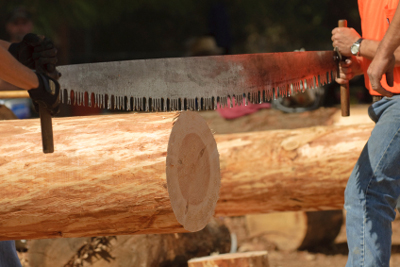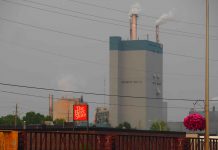 THUNDER BAY – Business – Resolute Forest Products Inc. has reported a net loss of $2 million for the year ended December 31, 2012. This is a representation of $0.02 per share, on sales of $4.5 billion. This compares with net income of $41 million, or $0.42 per diluted share, on sales of $4.8 billion in the year ended December 31, 2011.
THUNDER BAY – Business – Resolute Forest Products Inc. has reported a net loss of $2 million for the year ended December 31, 2012. This is a representation of $0.02 per share, on sales of $4.5 billion. This compares with net income of $41 million, or $0.42 per diluted share, on sales of $4.8 billion in the year ended December 31, 2011.
The net loss in the fourth quarter of 2012 was $36 million, or $0.38 per share, on sales of $1.1 billion, compared with a net loss of $6 million, or $0.06 per share, on sales of $1.1 billion in the fourth quarter of 2011.
Resolute Forest Products Income Report
The Company will hold a conference call to discuss the financial results at 9:00 a.m. (ET) today. The public is invited to join the call at (888) 789-9572 (pass code 9922866) at least fifteen minutes before its scheduled start time. A simultaneous webcast will also be available using the link provided under “Presentations and Webcasts” in the “Investors” section of www.resolutefp.com. A replay of the webcast will be archived on the Company’s website. A phone replay will also be available until February 27 by dialing (800) 408-3053 with the pass code 1158286.
Excluding $81 million of special items, net income for the full year was $79 million, or $0.81 per diluted share. Excluding special items of $70 million, net income in the fourth quarter was $34 million, or $0.35 per diluted share. For the full year 2011, net income excluding special items was $166 million, or $1.71 per diluted share, and $45 million, or $0.46 per diluted share, in the fourth quarter 2011. All special items and non-GAAP financial measures, such as adjustments for special items and adjusted EBITDA, are described and reconciled below.
“We significantly improved the Company’s competitiveness by optimizing our asset base, reducing costs wherever possible and strengthening our financial position this year,” said Richard Garneau, president and chief executive officer. “We added pulp assets, committed to growth projects in lumber, invested in power cogeneration plants and further optimized our paper assets, steps that will position us well for the future. At the same time, we returned $67 million to our shareholders in share buybacks, reduced balance sheet working capital by a further $81 million from the end of 2011 and redeemed an additional $85 million of debt.”
Operating Income Variance
The Company recorded an operating loss of $30 million in 2012, compared to operating income of $198 million in 2011. This reflects a $134 million increase in closure costs, impairment and other related charges, and $173 million of lower volume, in both cases because of additional market downtime and the Company’s ongoing efforts to focus production in its most cost-effective mills and drive better efficiency by restructuring and reducing labor costs. As a result, and in addition to lower energy, recovered paper and fiber costs, manufacturing costs improved by $55 million, excluding the effects of lower volume. The effect of pricing changes in the year was neutral as the increase in lumber pricing offset declines in pulp, while gains in specialty paper offset declines in newsprint and coated papers.
In the fourth quarter, the Company recorded an operating loss of $46 million, compared to operating income of $26 million in the third. This reflects $82 million in closure costs, impairment and other related charges, mainly related to the idling of a pulp mill and specialty paper machine in Fort Frances, Ontario, the closure of a specialty paper machine in Laurentide, Quebec, and costs related to the sale of assets in Mersey, Nova Scotia. The variance also included the unfavorable effects of a $10 million non-cash inventory obsolescence charge for slow-moving spare parts, $10 million unfavorable pricing and $8 million due to lower volume. The Company’s asset optimization and restructuring initiatives, as well as more favorable pricing for recovered paper, maintenance timing and a favorable wood products inventory adjustment, led to savings of $25 million in overall manufacturing costs, excluding the effects of lower volume.
SEGMENT DETAILS
Newsprint
The newsprint segment generated operating income of $18 million in the fourth quarter, an $8 million decrease from the third. Average transaction price slipped $6 per metric ton and shipments fell 2% as a result of newsprint export markets pressured by the strong U.S. dollar. There was a $4 million non-cash provision for spare parts obsolescence recorded against operating income in the quarter, but it was offset by lower manufacturing costs and favorable recovered paper pricing.
An 11% reduction in operating costs led to a 9% increase in operating income for the year, to $97 million, despite a 10% reduction in shipments and a 1% decrease in average transaction price. The Company reduced shipments as part of its efforts to manage its exposure to markets affected by the strong U.S. dollar and its steps to optimize its asset base, including the closure and subsequent sale of its interest in the Mersey newsprint mill.
Coated Papers
Operating income in the coated papers segment was unchanged in the fourth quarter compared to the third, at $3 million. Average transaction price rose $18 per short ton, or 2%, but shipments were down 14% as a result of equipment failures, which pushed operating costs per unit up 3%.
Operating income in the coated papers segment was down $48 million in 2012, to $9 million, as a result of a 3% reduction in average transaction price and a 13% reduction in shipments. The Company continued to make progress in its efforts to improve equipment efficiency with a smaller labor force, but operating costs per unit rose by 6% in the year, as the Catawba, South Carolina, mill continues to work toward capturing the expected efficiencies.
Specialty Papers
The specialty papers segment generated operating income of $8 million in the fourth quarter, an $18 million decrease from the previous quarter. Average transaction price was stable but shipments dropped 3% on lower demand. The decrease in operating income includes $4 million in additional costs associated with the Dolbeau, Quebec, facility’s ramp-up and a $3 million non-cash provision for spare parts obsolescence.
The restart of the Dolbeau facility is another step in the Company’s strategy to optimize its asset base; in the last five quarters, three specialty paper machines, one in each of Laurentide, Fort Frances and Kenogami, Quebec, were closed or idled, and the Company continued its labor restructuring initiatives, most recently in Alma, Quebec. Despite a 16% drop in shipments, consistent with the industry average, operating income rose 23% from 2011 to 2012, to $76 million, as average transaction price increased 3% and the Company improved manufacturing costs, including a $7 million improvement in labor costs and $14 million of favorable power and steam costs.
Market Pulp
Operating income was breakeven in the quarter, a $22 million improvement over the third. Average transaction price dropped $23 per metric ton, or 3%, from its already low levels in the third quarter. Despite indefinitely idling the Fort Frances pulp mill in late November, shipments rose 8% as the Company ran Fibrek’s Saint-Felicien, Quebec, facility throughout the quarter, except for four days of downtime to complete the dredging of many years of accumulated sludge in the lagoons. Manufacturing costs improved by $18 million as there was no major maintenance in the quarter.
Operating income in 2012 was $135 million lower than in 2011, reflecting primarily the $82 per metric ton drop in average transaction price (which includes, as of May 2012, the three Fibrek mills), but also an increase of $21 million in operating costs on higher chemicals, maintenance and labor costs. The five-week outage at Saint-Felicien had a $16 million negative impact on operating income.
Wood Products
The wood products segment reported operating income of $14 million in the fourth quarter, $8 million higher than the third. Average transaction price was unchanged but shipments rose 1%. There was a $7 million favorable inventory adjustment as a result of increasing market prices for lumber products.
As a result of stronger market conditions and gradually improving North American housing starts, operating income increased $51 million in the year, to $26 million, and average transaction price rose $53 per thousand board feet, or 18%. Shipments were down 9% as a result of the closure of the Oakhill sawmill in Nova Scotia and downtime in Quebec sawmills. Manufacturing costs rose $16 million mainly because of higher stumpage fees in Quebec, which is tied to lumber pricing.
CORPORATE & FINANCE
The Company used cash on hand to repurchase 1,946,205 shares of common stock during the fourth quarter under its previously announced share repurchase program, at a total cost of $22 million, and to redeem $85 million of its 10.25% senior secured notes due 2018. With $263 million of cash, the Company ended the quarter with $782 million of available liquidity, and $271 million in net debt.
OUTLOOK
Mr. Garneau added: “combined with softening demand and lower exports from North America, recent capacity restarts by competitors are putting pressure on pricing in newsprint and supercalender grades. We have focused our paper production in our most productive sites and drove better efficiency by restructuring mills and reducing labor costs. This gives us confidence in the competitiveness of our improved asset base as we face the challenges ahead. We expect to benefit in 2013 from investments in power cogeneration assets, with Saint-Felicien and Dolbeau now fully operational and Thunder Bay expected to come online by the end of the first quarter. Recent demand and pricing trends are giving us reason for cautious optimism that the pulp market is gradually coming out of its prolonged slump. Wood products should continue to show progress as housing starts build on recent improvements. Our ongoing growth projects – the capacity enhancement in Thunder Bay, in addition to the announced restart of the Ignace sawmill and construction of the new Atikokan sawmill to be completed in 2014 – further enhance our position in the lumber segment for the future.”





